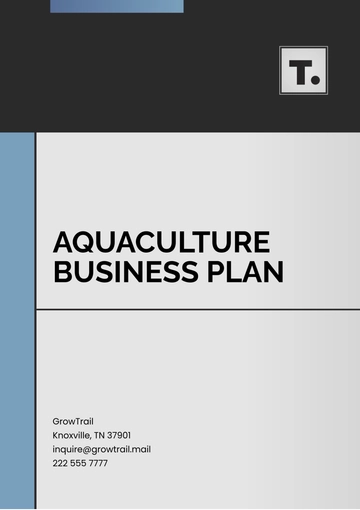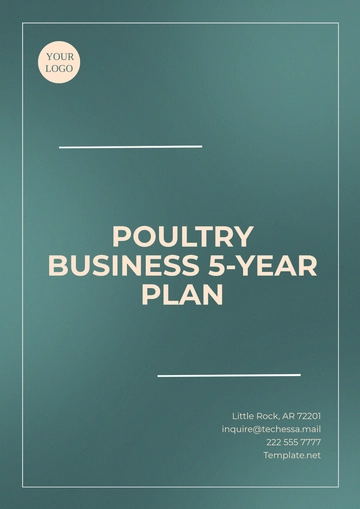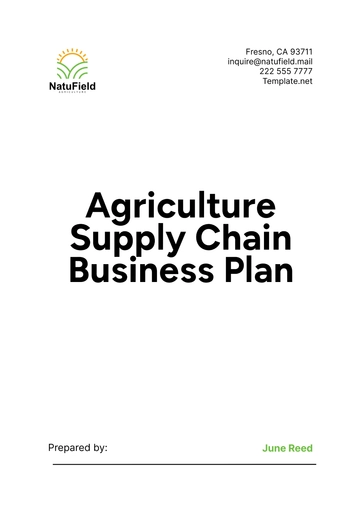Free Farming Business 5-Year Plan

1. Executive Summary
Green Acres Farm aims to become a leader in sustainable farming practices, focusing on organic crop production and livestock farming. With an emphasis on environmental stewardship, innovation, and local community support, the farm will diversify into new markets and increase production efficiency. The next five years will focus on expanding product lines, adopting new technologies, and securing a more significant market presence.
2. Mission and Vision Statements
A. Mission Statement:
Green Acres Farm's mission is to provide high-quality, sustainably grown agricultural products, including organic vegetables, fruits, and free-range meats, while nurturing the land, embracing innovative farming methods, and supporting the local community.
B. Vision Statement:
By 2065, Green Acres Farm aims to be a national leader in sustainable agriculture, promoting food security and environmental sustainability through innovative farming solutions, increased biodiversity, and reduced carbon footprint.
3. SWOT Analysis
Strengths:
High-quality organic produce and free-range meats.
Established customer base and strong local community ties.
Access to fertile farmland with diverse crops.
Strong commitment to sustainability and innovative practices.
Weaknesses:
Dependence on seasonal crop cycles leads to revenue fluctuations.
Limited market presence outside of the local region.
Initial high costs of technology integration and sustainability practices.
Opportunities:
Growing demand for organic and sustainable food products.
Expansion into regional and national markets.
Adoption of precision farming and AI-driven agricultural technologies.
Government incentives and grants for sustainable farming initiatives.
Threats:
Unpredictable climate change affecting crop yield and quality.
Volatile agricultural market prices and competition from large-scale industrial farms.
Potential regulatory changes that could increase operational costs.
4. Goals and Objectives
Long-term Goal:
By 2065, Green Acres Farm will increase its production capacity by 40%, reduce carbon emissions by 30%, and achieve carbon neutrality while maintaining its commitment to sustainable farming practices.Objectives:
Increase organic vegetable yield by 25% by adopting precision farming technologies by 2062.
Achieve 20% market share in the national organic food market by 2064.
Diversify product offerings by introducing organic dairy and sustainable aquaponics by 2063.
Reduce operational costs by 15% by improving energy efficiency and waste management techniques by 2065.
5. Key Strategies and Initiatives
Sustainable Farming Practices:
Implement water-saving technologies, such as drip irrigation and rainwater harvesting systems, and adopt soil health regeneration practices to enhance long-term fertility.Market Expansion:
Expand the distribution network into nearby metropolitan areas, starting with strategic partnerships with organic grocery chains and local restaurants.Product Diversification:
Launch a new line of organic dairy products, including milk, cheese, and yogurt, by 2063. Expand into aquaponics for year-round vegetable production by 2064.Technology Integration:
Invest in drone technology and AI-driven analytics to monitor crop health, optimize resource usage, and forecast yields. Introduce automated harvesting equipment to reduce labor costs.
6. Resource Allocation and Budget
Year 2060:
Initial investments in technology and infrastructure: $1,000,000.
Operating expenses: $600,000.
Projected revenue: $1,200,000.
Funding requirements: $500,000, sought through bank loans and agricultural grants.
Year 2061-2065:
2061: Expand into regional markets and purchase additional land for crop diversification – Budget: $700,000.
2062: Install precision farming technologies – Budget: $300,000.
2063: Launch dairy product line – Budget: $400,000.
2064-2065: Implement aquaponics systems and invest in sustainable energy sources (solar/wind) – Budget: $500,000.
Total Budget for 5 years: $3,900,000.
7. Timeline and Milestones
2060:
Complete technology upgrades (drones, precision farming tools).
Begina marketing campaign targeting local markets.
Diversify crop portfolio (introduce organic fruits and vegetables).
2061:
Expand product offerings to include organic grains (wheat, oats).
Begin market research for regional distribution.
Secure funding for equipment and technology.
2062:
Implement precision farming for more efficient crop management.
Reach the first milestone: Produce 10% more crops with 15% less water usage.
Develop relationships with regional grocery chains for distribution.
2063:
Launch an organic dairy line (milk, cheese, yogurt).
Expand into metropolitan areas.
Secure first national retail partnership.
2064-2065:
Integrate aquaponics systems for sustainable year-round vegetable production.
Achieve carbon-neutral certification.
Reach $5 million in annual revenue by 2065.
8. Risk Assessment and Contingency Plans
Risk 1: Climate-related crop failures (drought, floods).
Contingency Plan: Diversify crops to include drought-resistant varieties and invest in climate-smart farming technologies, such as controlled-environment agriculture.Risk 2: Rising commodity prices reduce profit margins.
Contingency Plan: Implement long-term fixed contracts with suppliers and distributors to stabilize pricing. Diversify into value-added products like packaged goods.Risk 3: Changing regulations on organic certification.
Contingency Plan: Stay proactive in understanding changes in organic farming certifications and adjust practices accordingly. Invest in regular certifications and quality assurance measures.
9. Evaluation and Key Performance Indicators (KPIs)
Revenue Growth:
Achieve a 10% annual growth in revenue, reaching $5 million by 2065.Market Share:
Capture 20% of the regional market for organic products by 2064.Sustainability Metrics:
Reduce water usage by 20% by 2063, and achieve carbon-neutral certification by 2065.Customer Satisfaction:
Maintain a customer satisfaction rate of 90% through regular feedback surveys and quality control.
10. Review and Adaptation Process
The business plan will be reviewed annually every December to evaluate progress, adjust goals, and ensure that strategies are aligned with industry trends. Key performance indicators will be assessed quarterly, and business plans will be adapted to address any shifts in market conditions, customer needs, or operational challenges. Any necessary adjustments will be made to ensure the farm’s growth and sustainability.
- 100% Customizable, free editor
- Access 1 Million+ Templates, photo’s & graphics
- Download or share as a template
- Click and replace photos, graphics, text, backgrounds
- Resize, crop, AI write & more
- Access advanced editor
Grow your farming business with the 5-Year Plan Template from Template.net. This editable, customizable template is designed for long-term agricultural planning. Adjust the details to meet your farm’s specific needs and goals, and make any changes easily by editing it in our Ai Editor Tool, making it the perfect planning solution.
You may also like
- One Page Business Plan
- Coffee Shop Business Plan
- Restaurant Business Plan
- Food Business Plan
- Real Estate Business Plan
- Executive Summary Business Plan
- Cover Page Business Plan
- Nonprofit Business Plan
- Daycare Business Plan
- Construction Business Plan
- Startup Business Plan
- Medical Business Plan
- Bakery Business Plan
- Service Plan
- Hotel Business Plan
- Catering Business Plan
- School Business Plan
- Healthcare Business Plan
- Transportation Plan
- Sports Plan
- Car Wash Business Plan
- Salon Business Plan
- Clothing Business Plan
- Farming Business Plan
- Boutique Plan





























